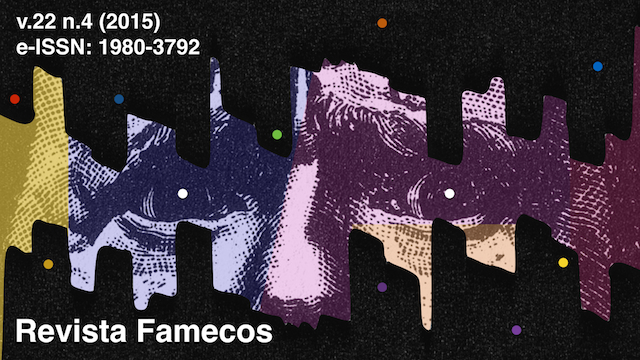Rethinking media displacement: the tensions between mobile media and face-to-face interaction
DOI:
https://doi.org/10.15448/1980-3729.2015.4.21005Keywords:
Phubbing, Media displacement, Mobile mediaAbstract
The neologism of phubbing, a coalesce of phone mediated activities and snubbing effects, caters to the public’s imperative to accentuate the ubiquitous perception of being annoyed, disregard, and offended in light of phone’s presence in co-present situation. Its symptomatic record accompanies important achievements of diffusing mobile media in developing countries, in which young people are one of the most active social groups in this scenario. By incorporating and relating to the theories of media displacement, we focus on the analysis of a Brazilian and Chinese young people survey, pinpointing how they understand and cope with the tensions between mobile media and face-to-face interaction. The results might provide new tissues to the discussions on media displacement.
Downloads
References
AUTER, P. J. Portable social groups: willingness to communicate, interpersonal communication gratifications, and cell phone use among young adults. International Journal of Mobile Communications, v.5, n. 2, p. 139-156, 2007.
AUXILIADORA DESSEN, M.; TORRES, C. V. Family and socialization factors in Brazil: An overview. Online readings in psychology and culture, v. 6, n. 3, 2002.
BAYM, N. K. Personal connections in the digital age. Polity, 2010.
BIAN, Y. . Bringing strong ties back in: Indirect ties, network bridges, and job searches in China. American sociological review, 1997. p. 366-385.
CAMPBELL, S. W.; RUSSO, T. C. The cocial construction of mobile telephony: an application of the social influence model to perceptions and uses of mobile phones within personal communication networks. Communication Monographs, v. 70, n.
, p. 317-334, 2003.
CNNIC. Research Report on Mobile Internet in China. 2014. Retrieved from: http://www.cnnic.cn/hlwfzyj/hlwxzbg/ydhlwbg/201408/P020140826360212699278.pdf Accessed in: mar. 2015.
DIMMICK, J.; CHEN, Y., & Li, Z. Competition between the Internet and traditional news media: The gratification-opportunities niche dimension. The Journal of Media Economics, v. 17, n. 1, 19-33, 2004.
FUNDAÇÃO TELEFONICA. Juventude Conectada. Agência de Conteúdo. 2014.
GARDNER, H.; DAVIS, K. The App generation: How today's youth navigate identity, intimacy, and imagination in a digital world. Yale University Press, 2013.
GERGEN, K. J. The challenge of absent presence. In: KATZ, J. E.; AAKHUS, M. (Eds.)., Perpetual contact: Mobile communication, private talk, public performance. Cambridge University Press, 2002.
GLOBO. Apaixonados por tecnologia ficam 48h sem celulares em 'praia detox'. 2015. Retrieved from: http://g1.globo.com/fantastico/noticia/2015/05/apaixonados-por-tecnologia-ficam-48h-sem-celulares-em-praia-detox.html. Accessed in: Mar. 2015.
GOLUB, A.; LINGLEY, K. Just Like the Qing Empire Internet Addiction, MMOGs, and Moral Crisis in Contemporary China. Games and Culture, v. 3, n. 1, p. 59-75, 2008.
GOFFMAN, E. Behavior in public places. Simon and Schuster. 2008.
HWANG, Y. Is communication competence still good for interpersonal media?: Mobile phone and instant messenger. Computers in Human Behavior, v. 27, n. 2, p. 924-934, 2011.
LENHART, A.; LING, R.; CAMPBELL, S.; PURCELL, K. Teens and Mobile Phones. Pew Research. 2010. Retrieved from: http://www.pewinternet.org/files/old-media//Files/Reports/2010/PIP-Teens-and-Mobile-2010-with-topline.pdf. Accessed in: Mar, 2015.
ISHII, K. Implications of mobility: The uses of personal communication media in everyday life. Journal of Communication, v. 56, n. 2, p. 346-365, 2006.
KAYANY, J. M.; YELSMA, P.. Displacement effects of online media in the socio-technical contexts of households. Journal of Broadcasting & Electronic Media, v. 44, n. 2, p. 215-229, 2000.
LAZARSFELD, P. F. Radio and the printed page. New York: Dell, Sloan and Pearce, 1940.
_____. BERELSON, B.; GAUDET, H. The People’s Choice. New York: Columbia University Press, 1948.
LING, R. New tech, new ties. Cambridge, MA: Mit Press, 2008.
_____. Children, youth, and mobile communication. Journal of Children and Media, v. 1, n. 1, p. 60-67, 2007.
NEWELL, J.; PILOTTA, J. J.; THOMAS, J. C. Mass media displacement and saturation. The International Journal on Media Management, v. 10, n. 4, p. 131-138, 2008.
PEOPLE.CN. What brings forth more and more “look down clan”? 2013. Retrieved from: http://opinion.people.com.cn/GB/363551/369083/index.html
PETERS, O.; BEN ALLOUCH. Always connected: a longitudinal field study of mobile communication. Telematics and Informatics, v. 22, n. 3, p. 239-256, 2005.
PETRIC, G., PETROVICIC, A.; VEHOVAR, V. Social uses of interpersonal communication technologies in a complex media environment. European Journal of Communication, v. 26, n. 2, p. 116-132, 2011.
PIERCE, T. Social anxiety and technology: Face-to-face communication versus technological communication among teens. Computers in Human Behavior, v. 25, n. 6, p. 1367-1372, 2009.
PRZYBYLSKI, A. K.; WEINSTEIN, N.. Can you connect with me now? How the presence of mobile communication technology influences face-to-face conversation quality. Journal of Social and Personal Relationships, v. 30, n. 3, p. 237-246, 2012.
QIU, J. L.. Working-class network society: Communication technology and the information have-less in urban China. MIT Press, 2009.
REID, D. J.; REID, F. J. Text or talk? Social anxiety, loneliness, and divergent preferences for cell phone use. CyberPsychology & Behavior, v. 10, n. 3, p. 424-435, 2007.
STROVER, S. A Retrospective on Convergence, Moral Panic, and the Internet. In Francis L. F. Lee, Louis Leung, Jack L. Qiu, & Donna S. C. Chu (Eds). Frontiers in new media research. Routledge, 2013. p. 132-154.
STALD, G. Mobile identity: Youth, identity, and mobile communication media. Youth, identity, and digital media, 2008. p. 143-164.
THOMPSON, K.. Moral panics. Routledge, 2013.
TURKLE, S. Alone together: Why we expect more from technology and less from each other. Basic books. 2012.
_____. Always-on/always-on-you: The tethered self. In: KATZ, J. E. (Ed). Handbook of Mobile Communication and Social Change. Cambridge, MA: MIT Press, 2006.
VAN CLEEMPUT. Friendship type, clique formation and the everyday use of communication technologies in a peer group: A social network analysis. Information, Communication & Society, v. 15, n. 8, p. 1258-1277, 2012.
YU, L.; TNG, T. H. Culture and design for mobile phones for China. In: KATZ, J. E. (Ed.). Machines that become us: The social context of personal communication technology. Transaction Publishers, p. 187-198, 2003.
YUAN, E. J. From “perpetual contact” to contextualized mobility: Mobile phones for social relations in chinese society. Journal of International and Intercultural Communication, v. 5, n. 3, p. 208-225, 2012.
Zhang, Q. Family communication patterns and conflict styles in Chinese parent-child relationships. Communication Quarterly, v. 55, n. 1, p. 113-128, 2007.
Downloads
Published
How to Cite
Issue
Section
License
Copyright
The submission of originals to Revista Famecos implies the transfer by the authors of the right for publication. Authors retain copyright and grant the journal right of first publication. If the authors wish to include the same data into another publication, they must cite Revista Famecos as the site of original publication.
Creative Commons License
Except where otherwise specified, material published in this journal is licensed under a Creative Commons Attribution 4.0 International license, which allows unrestricted use, distribution and reproduction in any medium, provided the original publication is correctly cited.






